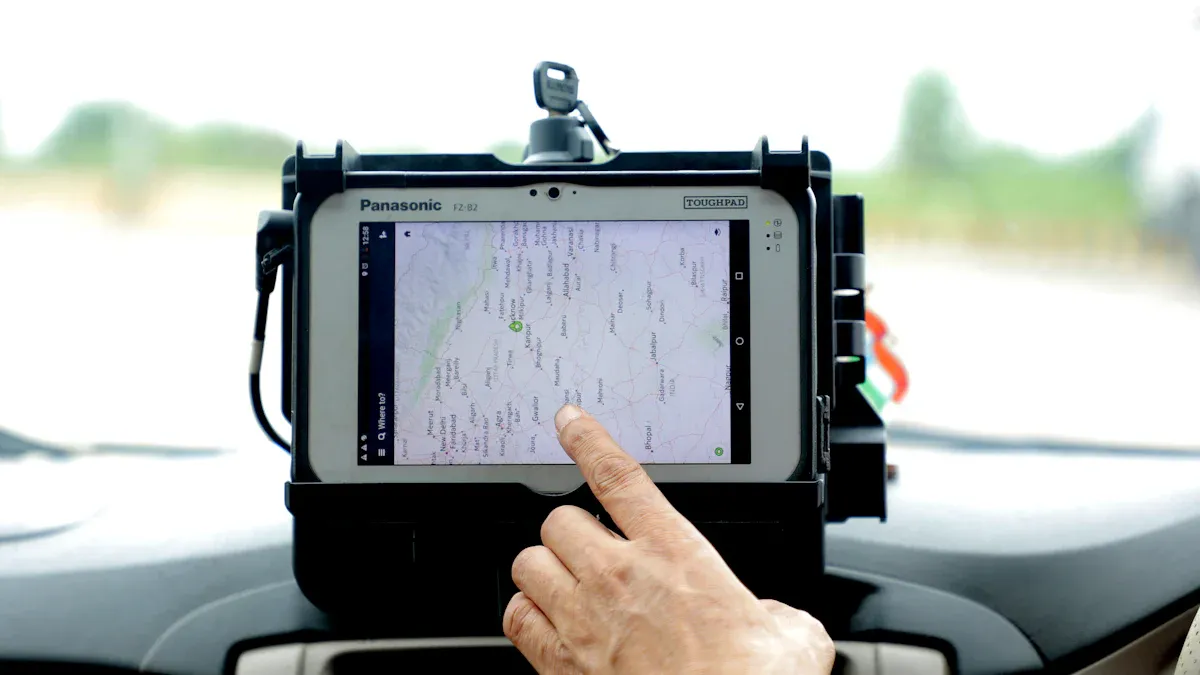Proven Ways to Increase Fleet Safety and Profitability with Analytics-duplicate

Analytics delivers measurable results for fleet operators seeking stronger safety and higher profits. Fleet managers rely on data-driven tools such as SmartIQ and SmartDrive Analytics to monitor performance and reduce risk. These solutions help organizations increase fleet safety, control costs, and improve daily operations.
SmartIQ and SmartDrive Analytics provide actionable insights that support safer driving and better business outcomes.
Key Takeaways
Real-time tracking helps managers spot unsafe driving early and respond quickly to prevent accidents.
Predictive maintenance reduces vehicle breakdowns and downtime, keeping fleets productive and saving money.
Driver behavior analytics encourage safer habits, lowering accident rates and improving fleet safety.
Fuel and route optimization cut costs by reducing waste and improving delivery efficiency.
Automated tracking ensures compliance, protects against legal risks, and simplifies fleet management.
Real-Time Tracking

Live Vehicle Monitoring
Fleet operators use real-time tracking and telematics to gain instant visibility into every vehicle’s location, speed, and status. Platforms like SmartDrive Analytics and the Solera Fleet Platform deliver live data streams that help managers monitor driver behavior, engine health, and road conditions. This information allows them to spot risky actions such as speeding or harsh braking before they lead to accidents. Crashes often follow warning signs like hard braking or sharp turns. Real-time tracking captures these early indicators, so managers can intervene quickly and prevent incidents.
Real-time alerts and in-cab notifications powered by machine vision and AI prompt drivers to self-correct, improving safety and reducing collisions over time.
With these tools, managers can also reduce unauthorized vehicle use, improve response times to emergencies, and ensure vehicles follow approved routes. Automated tracking supports compliance with regulations by providing accurate records of vehicle activity. Historical data helps identify patterns, enabling targeted coaching and proactive risk management.
Key benefits of live vehicle monitoring:
Immediate detection of unsafe driving behaviors
Faster response to incidents or route changes
Reduced risk of unauthorized vehicle use
Simplified compliance with safety protocols
Efficiency Gains
Real-time tracking does more than improve safety; it drives operational efficiency and profitability. Fleet managers use live data to rebalance workloads, reduce delays, and optimize routes. Accurate time and location data reveal where bottlenecks occur, allowing businesses to remove inefficiencies that impact the bottom line.
Automation of tracking reduces administrative work and errors, streamlining payroll and lowering labor costs.
Real-time insights help capture all billable time, leading to more accurate invoicing and stronger cash flow.
For every $1 invested in tracking software, businesses can see up to $4 in returns through improved productivity and resource allocation.
By leveraging platforms like SmartDrive Analytics and Solera Fleet Platform, fleets achieve measurable gains in both safety and profitability.
Data-Driven Maintenance
Preventive Actions
Fleet managers use analytics to predict maintenance needs before problems occur. SmartIQ’s predictive analytics and trend identification tools help managers spot early warning signs in vehicle data. These tools track engine hours, mileage, and sensor alerts. Managers can schedule maintenance at the right time, not too early or too late. This approach prevents unexpected breakdowns and keeps vehicles running smoothly.
SmartIQ transforms raw data into clear insights. Managers see patterns in wear and tear, oil changes, and brake usage. They can compare these trends across the fleet. This information helps them set benchmarks and create maintenance schedules that fit each vehicle’s needs. By acting on these insights, managers avoid costly repairs and extend the life of their assets.
Proactive maintenance reduces emergency repairs and keeps vehicles on the road longer, supporting both safety and profitability.
Downtime Reduction
Downtime happens when vehicles stop working due to repairs or breakdowns. Analytics-driven maintenance helps managers reduce these non-operational periods. When fleets use predictive tools, they fix issues before they cause breakdowns. This strategy keeps more vehicles available for work and improves overall productivity.
Key benefits of reducing downtime include:
Improved operational efficiency and customer satisfaction
Lower risk of overworking other vehicles and drivers
Fewer financial losses from disrupted schedules
Stronger company reputation
Technologies like SmartIQ and SHzoom’s Uptime platform provide real-time alerts and predictive insights. These tools help managers schedule maintenance efficiently and keep fleets in top condition. Reduced downtime turns a major challenge into a competitive advantage, boosting both safety and profitability.
Increase Fleet Safety

Driver Behavior Insights
Fleet managers rely on analytics to identify risky driving and coach drivers for safer habits. SmartIQ’s interactive safety KPIs and driver scorecard provide clear feedback on driving performance. These tools highlight behaviors such as speeding, harsh braking, and seat belt nonuse. Managers use this information to recognize top performers and support drivers who need improvement.
SmartIQ’s driver scorecard helps managers track progress and reward safe driving, which encourages retention and builds a culture of safety.
Advanced Driver Assistance Systems (ADAS), in-cab coaching, and harsh event monitoring work together to Increase Fleet Safety. Drivers receive real-time alerts when they make unsafe maneuvers. This immediate feedback helps them self-correct and avoid accidents. Studies show that drivers change their behavior when they know their actions are monitored and reviewed. Fleets using in-vehicle data recorders have seen accident rates drop by about 20%. Monitoring and feedback also improve seat belt use and reduce speeding.
Drivers modify their habits when they receive feedback on their actions.
Real-time alerts and post-event reports encourage safer driving.
Fleets with analytics-based monitoring experience fewer accidents.
Risk Reduction
Analytics-driven safety programs Increase Fleet Safety by reducing risk across the fleet. Managers use SmartIQ to spot trends and address issues before they lead to incidents. In-vehicle monitoring devices calculate risk indices for each trip, helping managers focus on the highest-risk drivers and routes. Validation tests show that these systems lower crash rates and risk scores soon after implementation.
ADAS and harsh event monitoring add another layer of protection. Managers receive alerts about dangerous maneuvers, allowing them to intervene quickly. Fleets that combine real-time monitoring with targeted coaching see the greatest improvements in safety. These strategies help Increase Fleet Safety, protect assets, and reduce costs linked to accidents.
Fleets that prioritize analytics-based safety programs build trust with customers and maintain a strong reputation in the industry.
Fuel and Route Optimization
Fuel Savings
Fleet managers face constant pressure to control fuel costs. Analytics platforms like SmartIQ help them meet this challenge by identifying high idling and inefficient driving patterns. SmartIQ’s idling analysis report pinpoints drivers who spend too much time idling and reveals the root causes. Managers use this information to coach drivers and set clear benchmarks for improvement.
Analytics can monitor many factors that influence fuel consumption. These include driver behavior, vehicle condition, and road environment. The most direct factors are driving technology and speed. Other important elements include driving skills, reaction ability, road geometry, lane layout, and traffic flow. By tracking these variables, analytics platforms help managers understand where fuel is wasted and how to fix it.
Key factors affecting fuel use:
Driving skills and speed
Reaction and decision-making ability
Road geometry and condition
Lane layout and driving scenario
Traffic flow characteristics
SmartIQ’s benchmarking tools allow fleets to compare fuel performance across drivers and vehicles, making it easier to reward top performers and address areas for improvement.
Reducing fuel waste leads to lower operating costs and higher profitability. Fleets that use analytics to manage fuel see measurable savings each month.
Smarter Routing
Route optimization is another area where analytics delivers strong results. SmartIQ and similar platforms analyze historical trip data and real-time traffic conditions. Managers use these insights to plan the most efficient routes for every job. This reduces unnecessary mileage, shortens delivery times, and cuts fuel expenses.
Analytics also helps fleets avoid congested roads and dangerous driving scenarios. By adjusting routes based on current conditions, managers keep drivers safe and on schedule. Smarter routing means fewer delays, less wear on vehicles, and improved customer satisfaction.
Fleets that embrace analytics-driven route planning gain a competitive edge through lower costs and better service. Every optimized mile adds up to greater profitability.
Compliance and Risk
Automated Tracking
Fleet managers use automated tracking to meet strict compliance standards. Analytics platforms record every trip, log vehicle inspections, and monitor driver safety training. These systems help managers separate personal and business mileage, which is essential for tax reporting. Automated tracking reduces errors and saves time. Managers receive instant alerts when vehicles miss inspections or drivers skip safety training.
Automated tracking lowers the risk of IRS penalties and audits by ensuring accurate records.
Companies that fail to track compliance face serious legal risks. Poor documentation can lead to higher insurance costs and denied claims. If a company vehicle gets involved in an accident during personal use, the company may face large legal settlements. Insurance policies often do not cover personal use, leaving companies exposed to financial losses. Failure to maintain compliance increases administrative work and legal exposure. Accidents can raise insurance premiums by up to 40%, making operations more expensive.
Key benefits of automated tracking:
Accurate mileage logs for tax compliance
Timely vehicle inspections and safety training
Reduced risk of costly litigation and insurance gaps
Lower administrative burden
Legal Protection
Analytics platforms provide strong legal protection for fleet operators. These systems collect safety data such as real-time driver alerts, video footage from both cabin and road, and driver scoring. Managers and insurers use this evidence to defend drivers after incidents. Instant video access and trip summaries allow for quick post-trip analysis and targeted coaching.
AI-powered analytics detect unsafe driving patterns and identify high-risk drivers.
ISO 27001 certification ensures data security and supports compliance with regulations like GDPR and HIPAA.
Detailed reporting helps managers reduce risk and improve safety policies.
Comprehensive analytics strengthen legal protection and support compliance, helping fleets avoid costly settlements and maintain a strong reputation.
Fleet operators who use analytics platforms gain peace of mind. They know their data is secure, their records are complete, and their drivers are protected. This approach reduces legal and financial risks, making compliance a key part of fleet profitability.
Analytics-driven solutions like SmartIQ and SmartDrive Analytics deliver immediate improvements in fleet safety and profitability. Case studies highlight rapid gains in driving skills, fuel savings, and lower costs. Fleets achieve results by leveraging actionable data, monitoring trends, and prioritizing data-first decisions. Companies that adopt these strategies Increase Fleet Safety, optimize expenses, and build a foundation for long-term success. Transitioning to data-driven operations ensures fleets stay competitive and prepared for future challenges.
Immediate insights drive safer, more profitable fleets.
Data-first strategies support continuous improvement.
FAQ
What is fleet analytics?
Fleet analytics uses data from vehicles and drivers to improve safety, efficiency, and profitability. Managers review reports and dashboards to make better decisions. Solutions like SmartIQ and SmartDrive Analytics provide real-time insights for daily operations.
How does analytics help reduce fleet costs?
Analytics identifies waste, such as high idling or inefficient routes. Managers use this information to coach drivers and optimize schedules. Lower fuel use and fewer repairs lead to direct cost savings.
Can analytics improve driver safety?
Yes. Analytics tracks risky behaviors like speeding or harsh braking. Managers use scorecards and real-time alerts to coach drivers. Safer driving reduces accidents and builds a positive safety culture.
Is it hard to start using fleet analytics?
No. Modern platforms like SmartIQ and SmartDrive Analytics offer user-friendly dashboards. Managers can access reports, set benchmarks, and receive alerts with minimal training.
What data does a fleet analytics platform collect?
A platform collects data on vehicle location, speed, engine health, driver behavior, and trip history. This information helps managers monitor performance and ensure compliance.
See Also
Maximizing Efficiency Within Your Automotive Supply Network
Revealing Expert Tips To Cut Costs In Logistics
Transforming Automotive Demand Forecasts Through Data Insights
